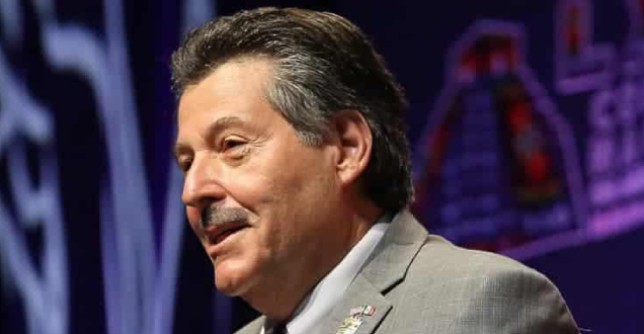Laredo Mayor Pete Saenz highlights improvements being made to the World Trade Bridge at the Texas-Mexico border.
Laredo Mayor Pete Saenz on Saturday highlighted work to remodel and expand the World Trade Bridge to speed up wait times for the 12,000 trucks crossing the Texas-Mexico border every day.
Saenz’s comments came during his speech at the 80th annual Congress of the Mexican Confederation of Associations of Customs Agents (CAAAREM) in Mérida, Mexico.
WTB improvements in Laredo include a paved lane for empty tractor-trailers to run directly from the bridge under the Free and Secure Trade (FAST) lane and the use of Z-portal technology, similar to X-ray machines, to make quick reviews of trucks.
“A truck can be processed in less than a minute; they can already identify the load that is there,” Saenz said, according to Mexico’s El Financiero newspaper. “This will eliminate 20 to 30% of the traffic, speeding up and making the crossing fluid. Those boxes will go through a Z-portal, which are ‘X-rays’ of inspection.”
Trucks coming into the U.S. from Mexico sometimes waited up to four hours between the checkpoint and the U.S. Customs and Border Protection review, not counting the time it took to get through the customs checkpoint in Mexico, according to customs officials.
The WTB FAST lane project eventually will expand to four lanes, but will begin with one lane.
Construction of a temporary roadway at the Laredo Port of Entry was completed last month. The city of Laredo had entered into a small-scale donation agreement with CBP and the General Services Administration to donate the roadway.
“We are excited to see these much-needed improvements to the World Trade Bridge and the facilitation measures to the newly implemented empty FAST lane,” said David P. Higgerson, Laredo Field Office director of field operations, in a CBP press release. “The ever-growing traffic volumes have far exceeded the limits of the present facilities and we will work hand in glove with our stakeholders at the federal, state and local levels to assist with improvements that will facilitate traffic at the busiest cargo facility in the southwest border.”
Saenz was quoted in that same press release as saying, “The upkeep and constant development of our bridges will ensure that Port Laredo remains competitive and continues as the port of choice for the trade industry. These improvements serve as vital assets to not only Laredo but the entire U.S. economy.”
CBP said small-scale partnerships with local community stakeholders assist in improving low-cost/time enhancements at ports of entry that have a high impact on the productivity of the border crossing. With an estimated value of $40,000, this project construction was completed in a week and a half and promotes faster processing, thus increasing the flow of traffic.
The total value of goods that crossed through Port Laredo was $234.7 billion in 2018, an increase of 9% over 2017, according to data from the U.S. Census Bureau. The number of trucks that crossed the border in both directions was almost 4.6 million.
During his speech Saturday, Saenz also discussed expanding the WTB facility from eight to 16 lanes in the future and having joint custom inspections between Mexican and U.S officials for goods being transported by rail.
“It depends on the studies — each [new truck] lane could cost $40 [million] to $50 million,” Saenz said.
Founded in 1938, CAAAREM represents the professional interests of customs brokers throughout Mexico. CAAAREM represents more than 800 customs agents working in maritime, air cargo, trucking and logistics and belonging to 38 different associations.
Along with Saenz, other officials attending the event included Nuevo Laredo Mayor Enrique Rivas. Nuevo Laredo, Mexico, is the sister city of Laredo, just across the U.S.-Mexico border.
“Nuevo Laredo is the commercial leader in Mexico,” Rivas said. “That’s why — together with Laredo Mayor Pete Saenz — we talked about the customs advantages of Nuevo Laredo and Laredo, the port of ‘Los Dos Laredos,’ at the 80th Congress of CAAAREM,” Rivas said.
Some of the other topics at this year’s 80th CAAAREM Congress included the Mayan Train, blockchain, artificial intelligence and the USMCA.
Mexican President Andrés Manuel López Obrador’s $6.5 billion Mayan Train is a proposed 948-mile railroad that would cut through the Yucatán Peninsula and connect Mayan temples for tourists. It has drawn criticism from the trade community, which has said the money should be spent improving Mexico’s highways and infrastructure or more freight trains should be added to the project.










